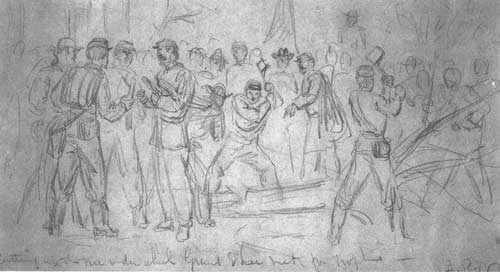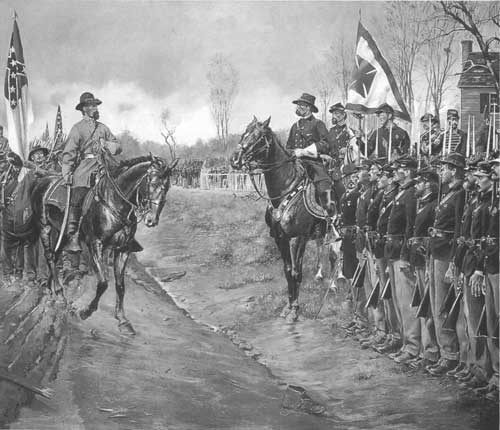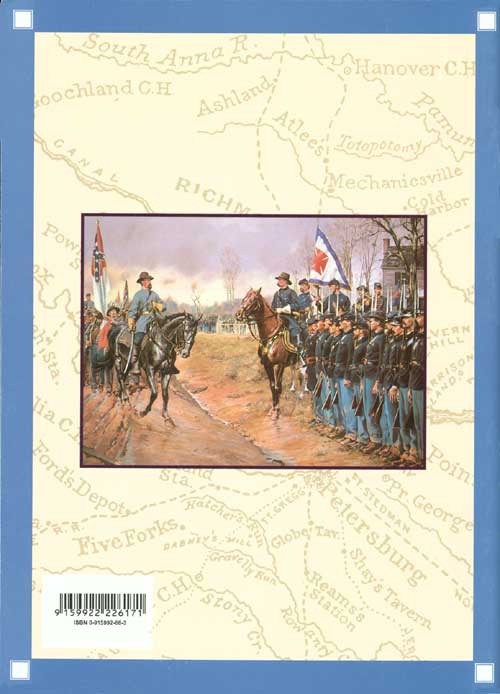|
Most of Lee's soldiers received their paroles by April 15. Then,
recalled a Tar Heel, "We were turned out into the world most of us
without any money, with one weatherbeaten suit of clothes, and nothing
to eat, entirely on the mercy of strangers." General Chamberlain never
forgot the sight that morning of these men "singly or in squads, making
their way into the distance, in whichever direction was nearest
home, and by nightfall we were left there at Appomattox Court House
lonesome and alone."

|
ALFRED WAUD SKETCH OF SOLDIERS CHOPPING UP THE APPLE TREE
UNDER WHICH GRANT AND LEE SUPPOSEDLY MET, FOR SOUVENIRS. (LC)
|

|
UNION SOLDIERS SHARING THEIR RATIONS WITH STARVING
CONFEDERATE TROOPS. (BL)
|
|
THE RETURN OF GENERAL LEE FROM THE MCLEAN HOUSE
This account is from Fighting for the Confederacy—The
personal Recollections of General Edward Porter Alexander. (Courtesy
of The University of North Carolina Press)
It was about half past four o'clock when we saw the general on old
Traveller, & Col. Marshall, who had accompanied him, appear in the
road returning; still about a half mile off. A strong desire seized me
to have the men do something, to indicate to the general that our
affection for him was even deeper than in the days of greatest victory
& prosperity.
Ordinary cheering seemed inappropriate, so I quickly sent & had
Col. Jno. Haskell, & all the artillery officers near, bring their
men & form them along the roadside, with orders to uncover their
heads, but in silence, as the general passed.
But the infantry line, being at rest & noting us artillerists at
something, swarmed down to see. And thus, as the general came up, our
few hundred artillery were swallowed up in a mob of infantry, & some
one started to cheer, & then, of course, all joined in.
And Gen. Lee stopped & spoke a few words. It was I believe only
the second time that he ever spoke to a crowd. The first occasion was
when a crowd at a station had called him from the train, as he went from
Washington City to Richmond to enter the service of Virginia at the
breaking out of the war. He advised them to go to their homes &
prepare for a bloody & desperate struggle.
Now, he told the men in a few words that he had done his best for
them & advised them to go home & become as good citizens as they
had been soldiers. As he spoke a wave of emotion seemed to strike the
crowd & a great many men were weeping, & many pressed to shake
his hand & to try & express in some way the feelings which shook
in every heart. As he passed on toward his camp he stopped & spoke
to me for a moment & told me that Gen. Grant had very generously
agreed that our soldiers could keep their private horses, which would
enable them to plant crops before it was too late. This seemed to be a
very special gratification to him. Indeed Gen. Grant's conduct toward us
in the whole matter is worthy of the very highest praise & indicates
a great & broad & generous mind. For all time it will be a
good thing for the whole United States, that of all the Federal generals
it fell to Grant to receive the surrender of Lee.
The terms of the surrender were drawn up by Gen. Grant himself in a
brief note rapidly written, & all the details as afterward carried
out seem to me a remarkable model of practical simplicity.
|

|
THIS IS A ROMANTICIZED DEPICTION OF LEE AND GRANT'S
MEETING ON APRIL 10, THE DAY AFTER THE SURRENDER
MEETING. IT WAS PAINTED IN 1922 BY STANLEY ARTHURS.
COURTESY DELAWARE STATE MUSEUMS, DOVER)
|
|
AFTER THE SURRENDER
by General Horace Porter
Mr. McLean had been charging about in a manner which indicated that
the excitement was shaking his nervous system to its center; but his
real trials did not begin until the departure of the chief actors in the
surrender. Then relic-hunters charged down upon the manor-house, and
began to bargain for the numerous pieces of furniture. Sheridan paid the
proprietor twenty dollars in gold for the table on which General Grant
wrote the terms of surrender, for the purpose of presenting it to Mrs.
Custer, and handed it over to her dashing husband, who galloped off to
camp bearing it upon his shoulder. Ord paid forty dollars for the table
at which Lee sat, and afterward presented it to Mrs. Grant, who modestly
declined it, and insisted that Mrs. Ord should become its possessor.
General Sharpe paid ten dollars for the pair of brass candlesticks;
Colonel Sheridan, the general's brother, secured the stone ink-stand;
and General Capehart the chair in which Grant sat, which he gave not
long before his death to Captain Wilmon W. Blackmar of Boston. Captain
O'Farrell of Hartford became the possessor of the chair in which Lee
sat. A child's doll was found in the room, which the younger officers
tossed from one to the other, and called the "silent witness." This toy
was taken possession of by Colonel Moore of Sheridan's staff, and is now
owned by his son. Bargains were at once struck for nearly all the
articles in the room; and it is even said that some mementos were
carried off for which no coin of the republic was ever exchanged. Of the
three impressions of the terms of surrender made in General Grant's
manifold writer, the first and third are believed to have been
accidently destroyed. The headquarters flag which had been used
throughout the entire Virginia campaign General Grant presented to me.
With his assent, I gave a portion of it to Colonel Babcock.
From Campaigning With Grant, originally published by The
Century Company.

|
TABLE AT WHICH LEE SAT (left); TABLE AT
WHICH GRANT WROTE THE ARTICLES OF SURRENDER (center); CHAIR IN WHICH
GRANT SAT (right).
|
|
Lee's surrender at Appomattox Court House did not end the Civil War.
Joseph E. Johnston's army in North Carolina held out until April 26, and
other C.S. military departments in the West continued to resist until
June 2, when the last of them, the Trans-Mississippi, formally
capitulated. The conflict was not legally ended until a presidential
proclamation of August 20, 1866, declared that "peace, order,
tranquility and civil authority now exist in and throughout the whole of
the United States."

|
LOCAL CITIZENS POSE IN FRONT OF THE CLOVER HILL TAVERN
SHORTLY AFTER THE WAR. (NPS)
|

|
AN 1865 LITHOGRAPH OF THE MEMORABLE EVENT. (LC)
|
The image of Appomattox Court House as a point of ending and
beginning grew with the passing years. It became the accepted practice
to date the war from the firing on Fort Sumter to the surrender at
Appomattox.
|
Yet the image of Appomattox Court House as a point of ending and
beginning grew with the passing years. It became the accepted practice
to date the war from the firing on Fort Sumter to the surrender at
Appomattox. Few significant military actions took place after
Appomattox. Author Fletcher Pratt, in his popular short history of the
conflict, ended his narrative on April 9. The same could be said for
other histories by Catton, Donald, and others. A committee appointed in
1892 to designate a national Civil War holiday wound up with a short
list of three events: Lincoln's birthday, the day the Emancipation
Proclamation was issued, and the date Lee surrendered at Appomattox.

|
A COPY OF "GENERAL ORDER NUMBER 9." (NPS)
|
|
THE FIFTH CORPS RECEIVES THE FORMAL SURRENDER
By General Meade's order the Fifth Corps, General Griffin in command,
was designated to receive the formal surrender. General Griffin, having
selected his former division, now commanded by General J. L.
Chamberlain, to receive the arms and colors of the Confederates.
At 9 A.M., April 12th, the One Hundred and Fifty-fifth was relieved
from its position on the skirmish line, which it had been occupying
continuously since the morning of the 9th, and with the Third Brigade
was drawn up on the right of the road leading into the village, muskets
loaded and bayonets fixed, General Chamberlain and staff on the right of
the line, adjacent to the hamlet. At 9:30, a half hour later, the
silvery tones of the bugles brought the troops to attention and soon the
first Confederate brigade made its appearance, marching through the
village and along the road in front of the Third Brigade. When the head
of the Confederate column reached the left of the Third Brigade, and
directly opposite the One Hundred and Fifty-fifth, their commander gave
the command, Halt! Close Up! Front Face! Stack Arms! Unsling Cartridge
Boxes! Hang on Stacks! This being done, the command was given, Right
Face! Forward! Countermarch by File Right, March! and away they went
unarmed and colorless, back to their camp.
As soon as this brigade, which it was learned was Evans' Brigade, of
Gordon's Corps, had departed, the troops of the Third Brigade, by orders
of General Chamberlain, then stacked arms and took down the Confederate
stacks, piling the muskets on the ground in their rear, muzzles outward.
One Confederate brigade succeeded another all day long, continuing until
nearly 5 P.M.; and as S. W. Hill, a member of the One Hundred and
Fifty-fifth, who was present at these final ceremonies, expresses it,
"There was no need to stop for lunch, as there was not a cracker nor a
bean in the Third Brigade, General Grant's orders of 30,000 rations to
the Confederates having exhausted the supplies of his own men."
It was evident that the Confederates were much dejected, though there
appeared an expression of relief on their faces as they marched away,
and their depression may have been caused more by hunger and emaciation
than by the chagrin of defeat. Most of them acted in a soldierly manner,
but occasionally one would display ill-temper by peevishly throwing his
cartridge box at the foot of the stacks instead of hanging it
thereon.

|
THE LAST SALUTE. (PAINTING BY DON TROIANI. PHOTO COURTESY OF
HISTORICAL ART PRINTS, SOUTHBURY, CT.)
|
The color guards, having stacked their arms, the color bearers
deposited their flag against their stacks some of them with tears in
their eyes bidding farewell with a kiss to the tattered rags they had
borne through so many dangers. The scene during the day was pathetic in
the extreme, and tears welled up in the eyes of many a seasoned veteran
in the Union lines.
When the last Confederate brigade had disappeared there was a pile
of muskets shoulder-high, which the army wagons soon hauled away. The
Army of Northern Virginia, the pride of the Confederacy, the invincible,
upon which their hopes and faith had been reposed, had disappeared
forever, existing thenceforth in memory only.
The total number of Confederates who received paroles at Appomattox
reached about 28,000, though less than half that number had arms to
surrender. Between the opening of the campaign on the 29th of March and
the 9th of April more than 19,000 prisoners and 689 pieces of artillery
had been captured.
Twenty-eight thousand hatless, shoeless, famishing men were cast
adrift by the collapse of the Confederacy, hundreds of miles from their
poverty-stricken homes. While the low-hovering smoke of battlefields had
lifted, yet the embers and ashes of war had left desolate the entire
intervening region, and the outlook of these disheartened and
penniless men was indeed cheerless. With the true American spirit of
humanity, those of the Union soldiers who had any money freely and
generously shared it with their former enemies, and many Confederates
were assisted to reach their homes in the Southwest by way of northern
railroads.
From Under the Maltese Cross, originally published by the
155th Pennsylvania Regimental Association.
|

|
BRIGADIER GENERAL JOSHUA L. CHAMBERLAIN (LC)
|
|
HONOR ANSWERS HONOR
The momentous meaning of this occasion impressed me deeply. I
resolved to mark it by some token of recognition, which could be no
other than a salute of arms.
Before us in proud humiliation stood the embodiment of manhood: men
whom neither toils and sufferings, nor the fact of death, nor disaster,
nor hopelessness could bend from their resolve; standing before us now,
thin, worn, and famished, but erect and with eyes looking level into
ours, walking memories that bound us together as no other bond—was
not such manhood to be welcomed back into a Union so tested and
assured?
Instruction had been given: and when the head of each division column
comes opposite our group, our bugle sounds the signal and instantly our
whole line from right to left, regiment by regiment in succession, gives
the soldiers salutation, from the order arms to the old carry—the
marching salute. Gordon at the head of the column, riding with heavy
spirit and downcast face, catches the sound of shifting arms, looks up,
and taking the meaning, wheels superbly, making with himself and his
horse one uplifted figure, with profound salutation as he drops the
point of his sword to the boot toe; then facing to his own command,
gives word for his successive brigades to pass us with the same position
of the manuel—honor answering honor. On our part not a sound of
trumpet more, nor roll of drum; not a cheer, nor word nor whisper of
vain glorying, nor motion of man standing again at the order, but an
awed stillness rather, and breath-holding as if it were the passing of
the dead!
As each successive division masks our own, it halts, the men face
inward towards us across the road, twelve feet away; then carefully
dress their line, each captain taking pains for the good appearance of
his company, worn and half starved as they were. The field and staff
take their positions in the intervals of regiments; generals in rear of
their commands. They fix bayonets, stack arms; then, hesitatingly,
remove cartridge-boxes and lay them down. Lastly, reluctantly, with
agony of expression—they tenderly fold their flags, battleworn and
torn, blood stained, heart-holding colors, and lay them down; some
frenziedly rushing from the ranks, kneeling over them, clinging to them,
pressing them to their lips with burning tears. And only the Flag of the
Union greets the sky!
From Joshua L. Chamberlain's memoir The Passing of the Armies,
G. P. Putnam's Sons, 1915
|

|
THE SURRENDER OF THE ARMY OF NORTHERN VIRGINIA, APRIL 12, 1865.
PAINTING BY KEN RILEY. COURTESY WEST POINT MUSEUM, U.S. MILITARY
ACADEMY, WEST POINT, NY)
|

|
VIEW OF THE COURTHOUSE BUILDING AND MCLEAN HOUSE,
CIRCA 1890. (NPS)
|
Appomattox Court House did not stop the guns, nor did it solve any
of the profound social and emotional issues that had ignited the war.
Yet in the desperate valor of the campaign leading up to it and in the
quiet dignity of Lee contrasted with the gruff magnanimity of Grant, it
somehow lifted a gentle mantle over the years of terrible bloodshed. It
was the symbol the nation craved to reassure it that
it was again whole. As the writer and diplomat James Russell Lowell
said when told that Lee had surrendered at Appomattox Court House, "I
felt a strange and tender exultation. I wanted to laugh and I wanted to
cry, and ended by holding my peace and feeling devoutly thankful. There
is something magnificent in having a country to love."

|
Appomattox Court House National Historical Park
(click on image for a PDF version)
|

|
Back cover: The Last Salute,
painting by Don Troiani. Photograph courtesy Historical Art Prints, Ltd.,
Southbury, Connecticut.
|
|
|
